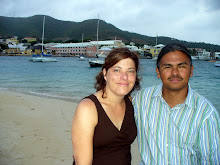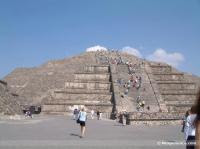 We had a relatively quiet day on Thursday. After a leisurely start to our morning, we went to Los Arquitos, a neighborhood in Oaxaca. Los Arquitos, the little arches, are part of the city’s 16th century aqueduct. The neighborhood is truly charming, with front doors to homes and businesses tucked under the arches.
We had a relatively quiet day on Thursday. After a leisurely start to our morning, we went to Los Arquitos, a neighborhood in Oaxaca. Los Arquitos, the little arches, are part of the city’s 16th century aqueduct. The neighborhood is truly charming, with front doors to homes and businesses tucked under the arches.
 After a brief walk, we headed south to Casa de Juarez, Benito Juarez’s home for 10 years while he lived in Oaxaca. Benito Juarez, who was president from 1858 until his death in 1872, is quite beloved throughout Mexico, and particularly in Oaxaca, where he was born. Juarez was born in the mountains and at age three, both his parents died. When he was 12, Juarez made his way to the city of Oaxaca where his older sister was working. He was illiterate and spoke only Zapotec, but caught the eye of Antonio Salanueva, his sister’s employer. Salanueva provided for Juarez and arranged for his placement in the seminary. Juarez went on to many, many great things, but he never forgot where he came from.
After a brief walk, we headed south to Casa de Juarez, Benito Juarez’s home for 10 years while he lived in Oaxaca. Benito Juarez, who was president from 1858 until his death in 1872, is quite beloved throughout Mexico, and particularly in Oaxaca, where he was born. Juarez was born in the mountains and at age three, both his parents died. When he was 12, Juarez made his way to the city of Oaxaca where his older sister was working. He was illiterate and spoke only Zapotec, but caught the eye of Antonio Salanueva, his sister’s employer. Salanueva provided for Juarez and arranged for his placement in the seminary. Juarez went on to many, many great things, but he never forgot where he came from. We stopped into the Templo de el Carmen Alta, which was right across the street, and then went to lunch. We had a delicious three course lunch: soup, entrée (Selso and I each had chicken with mole and rice) and a yummy lemon dessert. Orange juice was included. We ordered four “menus” (Rafael and Isa split theirs) and Selso ordered a couple of beers. Including tip, we paid about $27 -- quite a splurge for lunch! We stopped by a park we found on the way back to the house, and spent the rest of the day reading, relaxing and fighting over the computer!
 We were definitely ready for a change of pace yesterday, so we drove over an hour east to hike and swim at Hierve el Agua, a state park. Hierve el Agua, which means “where the water boils,” is most notable for its rock formations, which look like waterfalls.
We were definitely ready for a change of pace yesterday, so we drove over an hour east to hike and swim at Hierve el Agua, a state park. Hierve el Agua, which means “where the water boils,” is most notable for its rock formations, which look like waterfalls. There are four springs throughout the park which bubble up and run over the rocks. The water evaporates, but leaves behind minerals, mostly calcium carbonate. We went for a nice hike in the park and then had lunch.
There are four springs throughout the park which bubble up and run over the rocks. The water evaporates, but leaves behind minerals, mostly calcium carbonate. We went for a nice hike in the park and then had lunch.
 A couple of the springs have been dammed to create pools, and after lunch we enjoyed swimming (although the minerals do make it slippery).The water in the springs, incidentally, is not hot! Not at all. It was a warm day, though, so it felt good to cool off, and even better to lie in the sun and warm up afterwards.
A couple of the springs have been dammed to create pools, and after lunch we enjoyed swimming (although the minerals do make it slippery).The water in the springs, incidentally, is not hot! Not at all. It was a warm day, though, so it felt good to cool off, and even better to lie in the sun and warm up afterwards. After an enjoyable day, we headed home. Rafael napped but I read a story to the girls and the drive back passed quickly. We arrived in Oaxaca around 5 p.m. and decided to head to the zocalo for dinner. We wandered around a bit first, and listened to an orchestra playing music on a stage set up under the Catedral. After a nice dinner (pizza!), we returned to the stage, where a Ballet Folklorico performance was taking place. We stood (well, the kids made there way up front and sat) and watched for over an hour. They were really quite talented (not as good as Mexico City of course, but definitely better than the group we saw last weekend). It was a great ending to a wonderful day.
After an enjoyable day, we headed home. Rafael napped but I read a story to the girls and the drive back passed quickly. We arrived in Oaxaca around 5 p.m. and decided to head to the zocalo for dinner. We wandered around a bit first, and listened to an orchestra playing music on a stage set up under the Catedral. After a nice dinner (pizza!), we returned to the stage, where a Ballet Folklorico performance was taking place. We stood (well, the kids made there way up front and sat) and watched for over an hour. They were really quite talented (not as good as Mexico City of course, but definitely better than the group we saw last weekend). It was a great ending to a wonderful day.














 San Martine Tilcajete is home to a number of wood carvers. Although wood carving has a long tradition in Oaxaca, the recent popularity of the carvings has affected the folk art form. These days everything from fanciful creatures, to life-like animals, to frames, boxes and miniature tables and chairs are carved.
San Martine Tilcajete is home to a number of wood carvers. Although wood carving has a long tradition in Oaxaca, the recent popularity of the carvings has affected the folk art form. These days everything from fanciful creatures, to life-like animals, to frames, boxes and miniature tables and chairs are carved.




 Yesterday we went to Monte Alban, the archeological ruins of a large Zapotec city. Monte Alban is just a few miles from Oaxaca, up on a mountain top, which the Zapotec leveled to build their religious and economic center.
Yesterday we went to Monte Alban, the archeological ruins of a large Zapotec city. Monte Alban is just a few miles from Oaxaca, up on a mountain top, which the Zapotec leveled to build their religious and economic center.














 Just look at this bread! Selso is buying pan dulce for breakfast tomorrow morning.
Just look at this bread! Selso is buying pan dulce for breakfast tomorrow morning.







